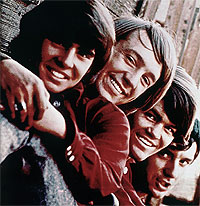Monkeyshines aside, band still spreading joy
 It’s no secret that many of today’s chart-topping teen acts aren’t as genuine as they seem – with artists routinely embracing shadow players, digital voice manipulation, an army of songwriters and even lip-syncing (well, for Britney, at least).
It’s no secret that many of today’s chart-topping teen acts aren’t as genuine as they seem – with artists routinely embracing shadow players, digital voice manipulation, an army of songwriters and even lip-syncing (well, for Britney, at least).
Such trade secrets were once highly guarded, said Micky Dolenz of the Monkees, the televised 1960s pop-rock band famous for breezy melodies and squeaky-clean mischief – but later lambasted by the news media and public when the quartet’s studio puppetry became known.
Those “discoveries” didn’t discourage him.
“To be honest, when you’re that famous and rich and popular with so many fans, quite frankly, I didn’t give a (expletive),” the lively 66-year-old said from Boston. “Now, of course, everybody’s admitting what they knew at the time.
“There’s not one Beach Boy (playing an instrument) on Good Vibrations. The Byrds didn’t play on … ( Mr. Tambourine Man); neither did the Mamas & the Papas. Everyone was using studio musicians. They just never talked about it.”
Central Ohioans who remember Last Train to Clarksville and A Little Bit Me, a Little Bit You can watch Dolenz and fellow Monkees Davy Jones and Peter Tork perform on Friday at the Lifestyle Communities Pavilion – live, up close and at face value.
Conceived by Hollywood filmmakers – and featuring actors found through a classified ad seeking “4 Insane Boys, Age 17-21” – plotlines of The Monkees were meant to mimic the 1964 Beatles mockumentary A Hard Day’s Night.
Famed songwriters such as Neil Diamond ( I’m a Believer) and Carole King ( Pleasant Valley Sunday) contributed to the Monkees catalog, which – at first – featured outside musicians on instruments.
Dolenz, the band’s drummer, hadn’t even played the instrument until being assigned his role.
“When they sold the pilot, I started taking lessons,” the longtime guitarist said. “It wasn’t like I was training to be a studio musician. I only was focused on learning the material I needed.”
Critics called the group the “prefab four.”
The shift from filming numbers to gigging as a full-fledged band wasn’t without challenges, said Dolenz, recalling the Monkees’ first live concert (in 1966 in Honolulu).
“That was a huge shock to the system,” he said. “No one had any idea what to expect.
“We’d rehearsed on the soundstage as we were filming this television show. It was insane. I couldn’t hear myself or anyone else playing because all the kids were screaming so loud.”
With growing disdain toward corporate oversight, meanwhile, the actors fought for creative rights to their destiny – recording much of the 1967 album Headquarters alone and starring in a bizarre, unsuccessful film titled Head.
But Monkee magic didn’t last. An exhausted Tork left in 1969, while Michael Nesmith decamped a year later. The group fizzled in 1971.
Although Dolenz doesn’t follow the trials or tunes of modern teen idols – he prefers High School Musical over Justin Bieber – the popular series Glee has found particular affection.
“It’s probably the closest thing to what The Monkees was like in the sense that our show was about an imaginary band but everybody in the cast could sing and play and dance,” said Dolenz, who has since pursued a theatrical career amid musical commitments.
” Glee is an imaginary show about a glee club. They can all actually do it, and they tour, so are they a real glee club or not?”
That debate could ring true for Dolenz, who has toured with various Monkees reunions and side projects.
It doesn’t take a lot to initiate a road trip – “It’s like ‘Make me an offer,'” the Los Angeles resident said jokingly – but the physical demands of performance and travel take their toll. (Nesmith isn’t touring with the group; Tork has repeatedly battled a rare head-and-neck cancer but was given a clean bill of health in 2009.)
“In some degrees, it’s tougher,” Dolenz said, “but the quality of the show and the lights and the video are infinitely better.”
The hordes of screaming young women may have grown older, yet memories of the band’s heyday haven’t dissipated.
“It tends to be three generations now” in the crowd, he said. “I’ll see a grandmother, a mother and a daughter; they’ve all turned each other on to the Monkees. It’s very amusing.”
Try finding that at a Jonas Brothers concert.
via Monkeyshines aside, band still spreading joy | The Columbus Dispatch.
 Follow us
Follow us Join us
Join us


